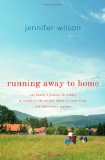We all think about running away at times. We imagine leaving the stresses and obligations of daily life and embarking on a life enhancing adventure. It’s doubtful, though, that Croatia tops the list of escapes for most people. Yet Jennifer Wilson, along with her husband and their two young children, left the comforts of home in Des Moines, Iowa, to take up temporary residence in Mrkopalj (MER-ko-pie), the mountain village in northwestern Croatia from which her maternal great-grandparents emigrated.
 Wilson chronicles her family’s sojourn in Running Away to Home: Our Family’s Journey to Croatia in Search of Who We Are, Where We Came From, and What Really Matters. It is a journey of family discovery more meaningful than she envisioned and into a world far different from their lives in middle America. And although Wilson sets out to discover her past, she learns more about living in the present.
Wilson chronicles her family’s sojourn in Running Away to Home: Our Family’s Journey to Croatia in Search of Who We Are, Where We Came From, and What Really Matters. It is a journey of family discovery more meaningful than she envisioned and into a world far different from their lives in middle America. And although Wilson sets out to discover her past, she learns more about living in the present.
Running Away to Home takes readers inside Mrkopalj and its environs. Wilson gives firsthand accounts of her and her family’s experiences. Although Wilson was the one in search of where she came from, her husband and children (six and almost four at the time) adapted more rapidly to village life and the cultural differences. One thing all of them learned is that life operates differently in a small mountain village. For example, the family agreed to rent the to-be-renovated second floor of the house of Robert Starcevic, who ran one of the town’s “bistros.” When they arrived, the remodeling had barely begun. Despite promises from Robert that it would be done in a day, a couple days, a week or two, the Wilsons never ended up living in the space they intended. Rather, they took over the smaller third floor of the house, which housed Robert’s daughters’ rooms. This was due in part to Robert often preferring to spend his days indulging in local libations and watching the world, a not uncommon activity in the village.
It may have been that approach that made a 21st Century American mother take the longest to acclimate. Rather than the constant motion of work and family activities back home, the 800 or so residents of Mrkopalj lived a slower pace. This doesn’t mean no one worked hard. To the contrary, Wilson found that life in the village could be “bone-hard.” There was no industry to speak of and many supported themselves by what they and their neighbors could grow, often on their own small plots. They would rise early to manually tend to their plots and livestock or to perform household chores. They would cut trees in the forest to gather firewood for the coming winter. Much of their work was done without the labor-saving conveniences most Americans would expect to use.
One major failing of the book, though, is that it contains no pictures, despite the fact Wilson’s web site contains 128 photos in a gallery called “Life in the Village.” Wilson says that was a conscious decision. She wants readers to come up with their own images of the village and its people in their minds. Yet virtually all readers have never taken such a step in location and daily life. Not sharing photographs in the book deprives them of actually seeing the people and sites that feature so prominently in it.
Although Wilson did not feel immediately accepted, she did catch up with her family in adjusting to and feeling the fabric of life in the village. Her search for her ancestors seemed less imperative and Wilson noted that she learned more about what their lives may have been like than about them personally. And, for her, that was perhaps the real lesson of their four months living in the village. Among other things, history and a sense of place seemed woven into the fabric of life. Croatia was far from immune from the political, nationalist and ethnic disputes that affected southeastern Europe and the Balkans. Yet while these fractures still lurked beneath the surface, they seemed far less important than the deep sense of community. This meant “they all lived together in messy harmony in Mrkopalj. In addition, for all our American advantages — jobs, industry, good malls — they felt sorry for me. No one in Mrkopalj could fathom what it must have been like to not even know my great-grandparents.”
Graced by an ability to increasingly turn at humorous eye at their acclimation process, Running Away to Home shows how the Wilsons seem to find themselves amidst a world much different than they knew. “Mrkopalj showed us that it didn’t matter what we had,” Wilson says. Instead, experiencing the small things that contributed to the life and culture of Mrkopalj stood in sharp contrast to and often felt more congruous than life in America, “a place where people had everything and appreciated so little.”
As Wilson and her family discover, even when you leave home it doesn’t mean you can’t find a niche and fellowship in other places, and in ways you might least expect.
You can’t run away from those things that make up the very fabric of your life — even if you change the scenery.
Jennifer Wilson, Running Away to Home







